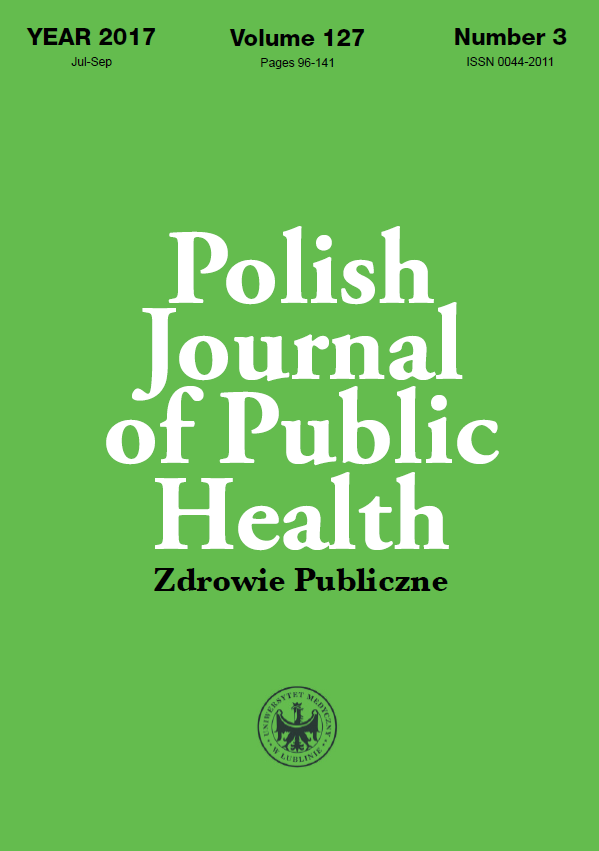Analysis of the quality of hospitalization based on the assessment of patients in Lublin, Poland
DOI:
https://doi.org/10.1515/pjph-2017-0025Słowa kluczowe:
public health, hospitalization, healthcare, patients’ assessmentAbstrakt
Introduction. The problem of health care affects every country. The structure and quality of hospitalization in Poland have changed over recent years. The state’s management of a balanced policy is possible prior to the collection of reports allowing to obtain data enabling assessment of changes in the health structure of the population, development of statistical data, as well as implementation and supervision of the National Health Program.
Aim. The aim of the study was to evaluate the quality of hospitalization basing on the patients’ assessment of the availability, conditions, course of treatment and contact with hospital staff in the city of Lublin.
Material and methods. The material for analysis was data collected from 254 patients. Respondents represented departments of diabetology, rehabilitation and internal diseases. The group consisted of 159 women and 95 men aged 19-84. The interview questionnaire was a research tool. Respondents were asked to assess: accessibility to hospital, efficiency of completing formalities when admitted to the hospital, cleanliness in the room, quality of the gastronomic services and contact with nursing and medical staff. Likert’s 5-point scale was used. Statistical analysis was performed using the software “STATISTICA 10.0”.
Results. Most respondents assessed the quality of hospitalization as satisfactory. As many as 99% of respondents assessed contact with doctors as good or very good. Contact with nursing staff was rated as good by 88% of respondents.
Conclusions. This study demonstrated good quality of health care in the examined hospital in Lublin. However, it is important to emphasize the need for further research aimed at collecting data on the presented problem.
Bibliografia
1. A WHO Collaborating Centre For Development of Quality and Safety in Health Systems: [http://www.cmj.org.pl/] (accessed: 12.03.2015).
2. Ustawa o powszechnym ubezpieczeniu zdrowotnym z dnia 6 lutego 1997 r. (Dz.U.1997.28.153).
3. Wojtyniak B, Goryński P. Sytuacja zdrowotna ludności Polski i jej uwarunkowania. Warszawa: Narodowy Instytut Zdrowia Publicznego, Państwowy Zakład Higieny; 2012.
4. Zdrowie i Ochrona Zdrowia w 2013 r. Social Surveys and Living Conditions Department, Central Statistical Office. Warszawa; 2014.
5. Zdrowie i Ochrona Zdrowia w 2015 r. Social Surveys and Living Conditions Department, Central Statistical Office. Warszawa; 2017.
6. Podstawowe dane z zakresu ochrony zdrowia w 2009 r. Social Surveys Division Central Statistical Office. Warszawa; 2010.
7. Centrum Systemów Informacyjnych Ochrony Zdrowia. [https://www.csioz.gov.pl/] (accessed: 30.10.2017).
8. Waldrop RD, Harper DE, Mandry C. Prospective assessment of triage in an urban emergency department. Southern Med J. 1997; 90(12):1208-12.
9. Horwitz LI. United States emergency department performance on wait time and length of visit. Ann Emerg Med. 2010;55(2):133-41.
10. Rozporządzenie Ministra Zdrowia z dnia 27 grudnia 2007 r. w sprawie sposobu i kryteriów ustalania dopuszczalnego czasu oczekiwania na wybrane świadczenia opieki zdrowotnej Dz.U.07.250.1884).
11. Krot K, Glińska E. Problem dostępu do usług medycznych po reformie służby zdrowia w Polsce. nierówności społeczne a wzrost gospodarczy. Uniwersytet Rzeszowski. 2003-2004;3:399-413.
12. Krogulski A. Hospitals location and indoor air microbiological quality. Rocz PZH. 2008;59(1):97-102.
13. Jarosz M. Zasady prawidłowego żywienia chorych w szpitalach. Warszawa: Wydawnictwo Instytutu Żywności i Żywienia; 2011.
14. Orkusz A, Zając E. Assessment of the energy and nutritional values of diets used in patients on the example of a chosen hospital in Great Poland. Eng Sci Technol. 2015;3(18).
15. Pokrzywa P, Cieślik E. Ocena sposobu żywienia pacjentów w szpitalach województwa małopolskiego. Żywność-Nauka Technologia Jakość. 2008;1(56):138-45.
16. Health at a Glance: Europe 2016: State of Health in the EU Cycle; OECD Publishing.
17. Aiken LH, Sermeus W, den Heede KV, et al. Patient safety, satisfaction, and quality of hospital care: cross sectional surveys of nurses and patients in 12 countries in Europe and the United States. BMJ. 2012;344:e1717.
Pobrania
Opublikowane
Numer
Dział
Licencja
Prawa autorskie (c) 2018 Polish Journal of Public Health

Praca jest udostępniana na licencji Creative Commons Attribution-NonCommercial-NoDerivatives 3.0 Unported License.


